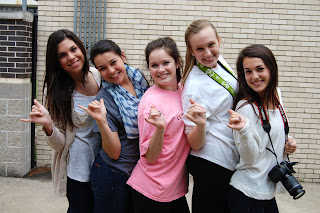Today in Photo J we focused on the last four tips of Kodak's Top Ten Tips. These four tips are move it from the middle, know your flashes range, watch the light, and be a picture director.
This photo is an example of move it from the middle. When using this technique, imagine a tic tac toe board over your picture. place your object where a horizontal and vertical line intersect. When deciding which side to place your photo on, pay attention to leading lines and if the way your subject is moving. If your subject is moving, make them run into the open space, no off the page.
This photo is an example of knowing your flashes range. As the photographer, know where the object needs to be for the flash to work effectively. Usually the range of the flash is from four to eight feet.
This photo is an example of the technique watch your light. Know your surroundings and the way the sun is shining. Knowing this will help your subject not have shadows on top of their face or body.
This photo is an example of being a picture director. Instead of taking a photo of a group of people randomly placed, arrange your subjects making them pose. Thinking about grouping and the final product will be beneficial when using this tip.
Hope you enjoyed these tips!- food, friends, and fashion.









